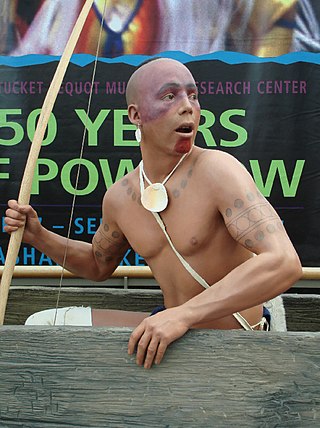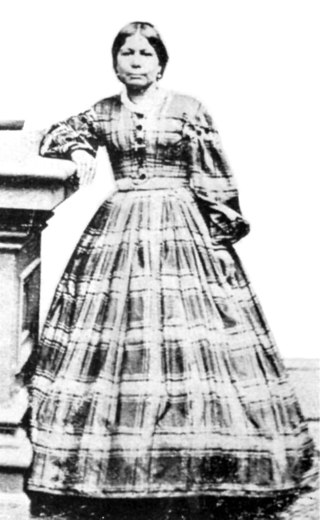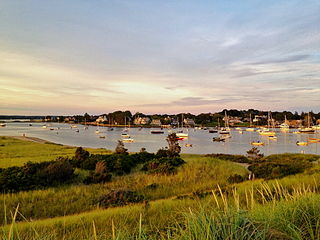
The Pequot are a Native American people of Connecticut. The modern Pequot are members of the federally recognized Mashantucket Pequot Tribe, four other state-recognized groups in Connecticut including the Eastern Pequot Tribal Nation, or the Brothertown Indians of Wisconsin. They historically spoke Pequot, a dialect of the Mohegan-Pequot language, which became extinct by the early 20th century. Some tribal members are undertaking revival efforts.

Montville is a town in New London County, Connecticut in the United States. The town is part of the Southeastern Connecticut Planning Region. The population was 18,387 at the 2020 census.
Uncasville is an area in the town of Montville, Connecticut, United States. It is a village in southeastern Montville, at the mouth of the Oxoboxo River where it flows into the Thames River. The name is now applied more generally to all of the east end of Montville, which is the area served by the Uncasville ZIP Code.

Miantonomoh, also spelled Miantonomo, Miantonomah or Miantonomi, was a chief of the Narragansett people of New England Indians.

Uncas was a sachem of the Mohegans who made the Mohegans the leading regional Indian tribe in lower Connecticut, through his alliance with the New England colonists against other Indian tribes.

The Pequot War was an armed conflict that took place in 1636 and ended in 1638 in New England, between the Pequot tribe and an alliance of the colonists from the Massachusetts Bay, Plymouth, and Saybrook colonies and their allies from the Narragansett and Mohegan tribes. The war concluded with the decisive defeat of the Pequot. At the end, about 700 Pequots had been killed or taken into captivity. Hundreds of prisoners were sold into slavery to colonists in Bermuda or the West Indies; other survivors were dispersed as captives to the victorious tribes.

The Narragansett people are an Algonquian American Indian tribe from Rhode Island. Today, Narragansett people are enrolled in the federally recognized Narragansett Indian Tribe. They gained federal recognition in 1983.

The Niantic are a tribe of Algonquian-speaking American Indians who lived in the area of Connecticut and Rhode Island during the early colonial period. They were divided into eastern and western groups due to intrusions by the more numerous and powerful Pequots. The Western Niantics were subject to the Pequots and lived just east of the mouth of the Connecticut River, while the Eastern Niantics became very close allies to the Narragansetts. It is likely that the name Nantucket is derived from the tribe's endonym, Nehantucket.

Ninigret was a sachem of the eastern Niantic Indian tribe in New England at the time of colonization, based in Rhode Island. In 1637, he allied with the colonists and the Narragansetts against the Pequot Indians.
Wyandanch (c. 1571 – 1659 was a sachem of the Montaukett Indians in the mid-17th century on eastern Long Island. Initially he was a minor chief among the Montaukett, but due to his skillful manipulation of various alliances and his accommodating stance towards the European colonists who gave him substantial military and economic support, he eventually became an influential "alliance chief" (a sachem who was responsible for maintaining friendly relations between his tribe and the settlers).

The Mystic massacre – also known as the Pequot massacre and the Battle of Mystic Fort – took place on May 26, 1637 during the Pequot War, when a force from Connecticut Colony under Captain John Mason and their Narragansett and Mohegan allies set fire to the Pequot Fort near the Mystic River. They shot anyone who tried to escape the wooden palisade fortress and killed most of the village. There were between 400 and 700 Pequots killed during the attack; the only Pequot survivors were warriors who were away in a raiding party with their sachem Sassacus.
The Mohegan are an Algonquian Native American tribe historically based in present-day Connecticut. Today the majority of the people are associated with the Mohegan Indian Tribe, a federally recognized tribe living on a reservation in the eastern upper Thames River valley of south-central Connecticut. It is one of two federally recognized tribes in the state, the other being the Mashantucket Pequot, whose reservation is in Ledyard, Connecticut. There are also three state-recognized tribes: the Schaghticoke, Paugusett, and Eastern Pequot.
The Podunk were an indigenous people who spoke an Algonquian Quiripi language and lived primarily in what is now known as Hartford County, Connecticut, United States. English colonists adopted use of a Nipmuc dialect word for the territory of this people.

Mohegan Indians v. Connecticut (1705–1773) was the first indigenous land rights litigation in history in a common law jurisdiction. James Youngblood Henderson, professor of law, calls the case "the first major legal test of indigenous tenure." Robert Clinton calls it the "first formal litigation of North American Indian rights."

The Mohegan Tribe is a federally recognized tribe and sovereign tribal nation of the Mohegan people. Their reservation is the Mohegan Indian Reservation, located on the Thames River in Uncasville, Connecticut.

Emma Tyler Fielding Baker Dec. 5, 1828 - Jan. 20, 1916) was a member of the Mohegan Pequot Indian tribe and was posthumously awarded the title of Mohegan medicine woman in 1992. Medicine women were culture-bearers and required to have an in-depth knowledge of tribal customs and possess good leadership qualities. She was also a tribal historian and ceremonial leader of the Mohegan Tribe.
The Treaty of Hartford was a treaty concluded between New England, the Mohegan and the Narragansett on September 21, 1638, in Hartford, Connecticut.

Harman Garrett was a Niantic sachem and then governor of the Eastern Pequots slightly east of the Pawcatuck River in what is now Westerly, Rhode Island. His chosen English name was very similar to that of Herman Garrett, a prominent colonial gunsmith from Massachusetts in the 1650s.

Robin Cassacinamon (c.1620s-1692) was a Pequot Indian governor appointed by the United Colonies to govern Pequots in southeastern Connecticut.
















